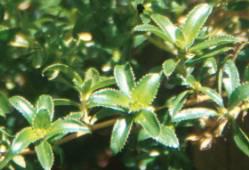Cliffortia ferruginea
Cliffortia ferruginea L.f.
Family: Rosaceae
Common names: glossy cliffortia (Eng.); glastee, pypsteelbos, teringtee (Afr.)
Introduction
A hardy, attractive ground cover with glossy green foliage that is so very versatile it can find a place to please in any everyone's garden.
Description
Description
Cliffortia ferruginea is a fast-growing, spreading, herbaceous ground cover that forms a dense carpet from 300 to 500 mm in height. Leaves are small, toothed, dark green and shiny and are the plant's best feature. It produces minute, white to pinkish flowers in summer to winter, from November to July. Male and female flowers occur on different plants. Flowers are followed by small, dry, encapsulated seeds.
Distribution and habitat
Distribution description
It is found on flats and lower slopes, usually near water, from the Cape Peninsula to Port Elizabeth.
Derivation of name and historical aspects
History
The genus name honours George Clifford, a rich Anglo-Dutch financier and a Director of the Dutch East India Company who was also a keen horticulturist. In Amsterdam, Linnaeus stayed with Clifford, who owned a large, famous garden and the Zoo; around 1735, Linnaeus named the genus after his patron.
The rose family is very large and economically important; it is mostly found occurring naturally in the temperate regions of the northern hemisphere. It comprises 120 genera with 3 000 species world-wide, and includes well-known members such as apples, plums and prunes ( Prunus ), pears ( Pyrus ), loquat ( Eriobotrya ), brambles ( Rubus ) and strawberries ( Fragaria ). This family also includes some popular ornamental plants namely roses (Rosa), Crataegus, Pyracantha and Cotoneaster. Rosaceae is, however, a poorly represented family in southern Africa with only nine genera and about 150 species.
Other noteworthy members of this genus are: Cliffortia ruscifolia (climber's friend or steekbos ), a prickly shrub with a very strong root system that allows climbers to pull themselves up difficult places and up rock faces without giving way; and an infusion of the leaves of C. odorata, a lush, dense-growing shrub, can be used to treat haemorrhoids, sore throats and bladder and menstrual complaints.
Ecology
Ecology
Flowers are wind pollinated and are unisexual (male or female) which means that stamens and ovaries do not occur in the same flower.
Uses
Use
The branches are long and slender and rigid with a narrow pith-channel that can be hollowed out with a thin wire and used to form the stem (steel) of a pipe (pyp), hence the common name pypsteelbos. A tea brewed with Cliffortia ferruginea leaves can be used to treat chest complaints such as consumption (tering) and bronchitis, hence the common name teringtee. The glas in the common name glastee refers to the brittle nature of the stems and branches, i.e. as brittle as glass, while the tee refers to the plant being used to make a medicinal tea.
Growing Cliffortia ferruginea
Grow
Cliffortia ferruginea can be grown in full sun or semi-shade, although it does form a tighter carpet in full sun. It can be used very effectively on slopes/banks as a ground-covering plant, and is also very attractive when allowed to trail over retaining walls. It is equally useful in mixed borders, rockeries, pots or in hanging baskets.
In the garden Cliffortia ferruginea is a very easy-to-care-for plant, adapting to most soils, surviving on very little water and spreading in a controllable manner to cover open ground spaces. The basic requirements are full sun and well-drained soil. Very good in coastal gardens, it is hardy and water-wise.
Propagate from cuttings that root easily within 2 to 3 weeks, in spring and autumn, or by removing rooted runners. The young plants react very well to feeding, and pinching the tips of the young stems encourages bushy growth.
References
- Jackson, W.P.U. 1977. Wild flowers of Table Mountain. Howard Timmins, Cape Town.
- Jackson, W.P.U. 1980. Wild flowers of the fairest Cape. Howard Timmins, Cape Town.
- Leistner, O.A. (ed.). 2000. Seed plants of southern Africa : families and genera. Strelitzia 10. National Botanical Institute, Pretoria.
- Levyns, M.R. 1966. Guide to the flora of the Cape Peninsula, edn 2. Rustica Press, Cape Town.
- Mustart, P., Cowling, R. & Albertyn, J. 1997. Southern Overberg. South African Wild Flower Guide 8. Botanical Society of SA, Cape Town.
- Powrie, F. 1998. Grow South African plants. National Botanical Institute, Cape Town.
- Smith, C.A. 1966. Common Names of South African Plants. Dept. of Agricultural Technical Services, Botanical Survey Memoir No 35, Government Printer, Pretoria.
- Trinder-Smith, T.H. 2003. The Levyn's guide to the plant genera of the southwestern Cape. Bolus Herbarium, Cape Town.
- Van Jaarsveld, E. 2000. Wonderful water-wise gardening. Tafelberg, Cape Town.
Credits
Cherise Viljoen
Kirstenbosch National Botanical Garden
September 2005
Plant Attributes:
Plant Type: Ground Cover, Perennial, Scrambler
SA Distribution: Eastern Cape, Western Cape
Soil type: Sandy, Clay, Loam
Flowering season: Late Summer, Autumn, Winter
PH: Acid, Neutral
Flower colour: White, Pink
Aspect: Full Sun, Morning Sun (Semi Shade), Afternoon Sun (Semi Shade)
Gardening skill: Easy
Special Features:
Horticultural zones











Rate this article
Article well written and informative
Rate this plant
Is this an interesting plant?
Login to add your Comment
Back to topNot registered yet? Click here to register.